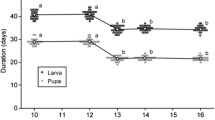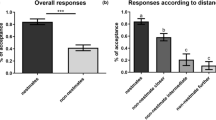Abstract
The male-produced aggregation pheromone inIps paraconfusus is composed of three compounds. Female bark beetles were exposed to combinations of these compounds, presented as point sources in an enclosed, circular arena. By itself,cis-verbenol (cV) had no effect on the number of beetles that reached the source. Either ipsenol (Ip) alone or ipsdienol (Id) alone strongly increased the number that reached the source, with Id producing a dose-response curve with a much steeper slope. cV moved the onset of the response to Id to higher doses of Id, but the response rose more rapidly after onset than when cV was absent. Overall, cV inhibited the effect of Id except at the highest dose. cV affected the onset of the response to Ip little or none, but strongly increased the slope of the response, synergizing the effect of Ip. The responses to combinations of Id and Ip were related to the log of a linear combination of their doses. The results are consistent with a model where Id and Ip act at a single site of action, but with different potencies, while cV appears to modify the effects of Id and Ip, rather than affecting the site of action directly.
Similar content being viewed by others
References
Akers, R.P. 1989. Counterturns initiated by decrease in rate of increase of concentration: Possible mechanism of chemotaxis by walking femaleIps paraconfusus bark beetles.J. Chem. Ecol. 15:183–208.
Akers, R.P., andWood, D.L. 1989a. Olfactory orientation responses by walking femaleIps pamconfusus bark beetles: I. Chemotaxis assay.J. Chem. Ecol. 15:3–24.
Akers, R.P., andWood, D.L. 1989b. Olfactory orientation responses by walking femaleIps paraconfusus bark beetles: II. In an anemotaxis assay.J. Chem. Ecol. 15:1147–1159.
Baker, T.C., Cardé, andRoelofs, W.L. 1976. Behavioral responses of maleArgyrotaenia velutinana (Lepidoptera: Tortricidae) to components of its sex pheromone.J. Chem. Ecol. 2:333–352.
Bartley, S.H. 1958. Principles of Perception. Harper and Row, New York, 482 pp.
Birch, M.C., Light, D.M., Wood, D.L., Browne, L.E., Silverstein, R.M., Bergot, B.J., Ohloff, G., West, J.R., andYoung, J.C. 1980. Pheromonal attraction and allomonal interruption ofIps pini in California by the two enantiomers of ipsdienol.J. Chem. Ecol. 6:703–718.
Boeckh, J. 1977. Aspects of nervous coding of sensory quality in the olfactory pathway of insects, pp. 308–322,in D. White (ed.). Proceedings of the 15th International Congress of Entomology. Entomology Society of America.
Cain, W.S. 1978. History of research on smell, pp. 197–229,in M.P. Friedman (ed.). Handbook of Perception, Vol. VIA: Tasting and Smelling.
Dethier, V.G. 1963. The Physiology of Insect Senses. Wiley & Sons, New York, 266 pp.
Finney, D.J. 1971. Probit Analysis, 3rd ed. Griffin, London.
Kaissling, K.E.. andPriesner, E. 1970. Die Riechschwelle de Seidenspinners.Naturwissenschaften 57:23–28.
Klun, J.A., Chapman, O.L., Mattes, K.C., Wojkowski, P.W., Beroza, M., andSonnet, P.E. 1973. Insect sex pheromones: Minor amount of opposite geometrical isomer critical to attraction.Science 181:661–663.
Lanier, G.N., Classon, A., Stewart, T., Piston, J.J., andSilverstein, R.M. 1980.Ips pini: The basis for interpopulational differences in pheromone biology.J. Chem. Ecol. 6:677–687.
Light, D.M. 1983a. Sensitivity of antennae of male and femaleIps paraconfusus (Coleoptera: Scolytidae) to their natural aggregation pheromone and its enantiomeric components.J. Chem. Ecol. 9:561–584.
Light, D.M. 1983b. Sensitivity of antennae of male and femaleIps paraconfusus (Coleoptera: Scolytidae) to its pheromone and other behavior-modifying chemicals.J. Chem. Ecol. 9:585–606.
Linn, C.E., Bjostadt, L.B., Du, J.W., andRoelofs, W.L. 1984. Redundancy in a chemical signal: Behavioral responses of maleTrichoplusia ni to a 6-component sex pheromone blend.J. Chem. Ecol. 10:1309–1324.
MacGregor, R.J., andLewis, E.R. 1977. Neural Modelling: Electrical Signal Processing in the Nervous System. Plenum Press, New York, 414 pp.
McCullagh, P., andNelder, J.A. 1989. Generalized Linear Models, 2nd ed. Chapman and Hall, New York.
Mustaparta, H. 1979. Chemoreception in the bark beetles of the genusIps: Synergism, inhibition, and discrimination of enantiomers, pp. 147–158,in F.J. Ritter (ed.). Chemical Ecology: Odor Communication in Animals. Elsevier, New York.
Mustaparta, H., Angst, M.E., andLanier, G.N. 1977. Responses of single receptor cells in the pine engraver beetle,Ips pini (Say) (Coleoptera: Scolytidae) to its aggregation pheromone, ipsdienol, and the aggregation inhibitor, ipsenol.J. Comp. Physiol. 121:343–347.
Mustaparta, H., Angst, M.E., andLanier, G.N. 1979. Specialization of olfactory cells to insect-and host-produced volatiles in the bark beetleIps pini (Say).J. Chem. Ecol. 5:109–123.
Payne, C.D. (ed.). 1986. The GLIM system release 3.77 manual. Numerical Algorithms Group, Oxford, U.K.
Robertson, J.L., andPreisler, H.K. 1991. Pesticide Bioassay with Arthropods. CRC Press, Boca Raton, Florida.
Rudinsky, J.A. 1973. Multiple functions of the Douglas fir beetle pheromone 3-methyl-2-cyclo-hexen-1-one.Environ. Entomol. 2:579–585.
Rudinsky, J.A., andRyker, L.C. 1980. Multifunctionality of Douglas-fir beetle pheromone 3,2-MCH confirmed with solvent dibutyl phthalate.J. Chem. Ecol. 6:193–201.
Schnieder, D., Block, B.C., Boeckh, J., andPriesner, E. 1967. Die Reaktion der mannlichen Seidenspinner auf Bombykol und seine Isomeren: Elektroantennogramm und Verhalten.Z. Vergl. Physiol. 54:192–209.
Schwink, I. 1958. A study of olfactory stimuli in the orientation of moths.Proc. 10th. Int. Cong. Entomol. 2:577–582.
Seybold, S.J. 1992. The role of chirality in the olfactory-directed behavior of pine engraver beetles in the genusIps (Coleoptera: Scolytidae). PhD dissertation. University of California, Berkeley.
Silverstein, R.M., Rodin, J.O., andWood, D.L. 1966. Sex attractants in frass produced by maleIps confusus in ponderosa pine.Science 154:509–510.
Somjen, G. 1972. Sensory Coding in the Mammalian Nervous System. Meredith Corp., New York, 386 pp.
Wood, D.L., Browne, L.E., Silverstein, R.M., andRodin, J.O. 1966. Sex pheromones of bark beetles: I. Mass production, bioassay, source, and isolation of the sex pheromone ofIps confusus (LeC.)J. Insect Physiol. 12:523–536.
Wood, D.L., Stark, R.W., Silverstein, R.M., andRodin, J.O. 1967. Unique synergistic effects produced by the principal sex attractant compounds ofIps confusus (LeConte) (Coleoptera: Scolytidae).Nature 215:206.
Wood, D.L., Browne, L.E., Bedard, W.D., Tilden, P.E., Silverstein, R.M., andRodin, J.O. 1968. Response ofIps confusus to synthetic sex pheromones in nature.Science 159:1373–1374.
Author information
Authors and Affiliations
Rights and permissions
About this article
Cite this article
Akers, R.P., Preisler, H.K. & Wood, D.L. Interactions between components of the aggregation pheromone during chemotaxis by the bark beetleIps paraconfusus . J Chem Ecol 19, 863–879 (1993). https://doi.org/10.1007/BF00985016
Received:
Accepted:
Issue Date:
DOI: https://doi.org/10.1007/BF00985016




